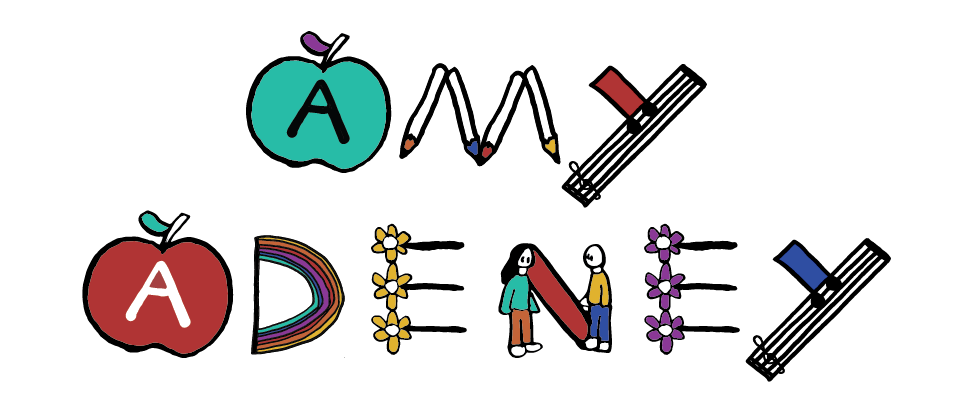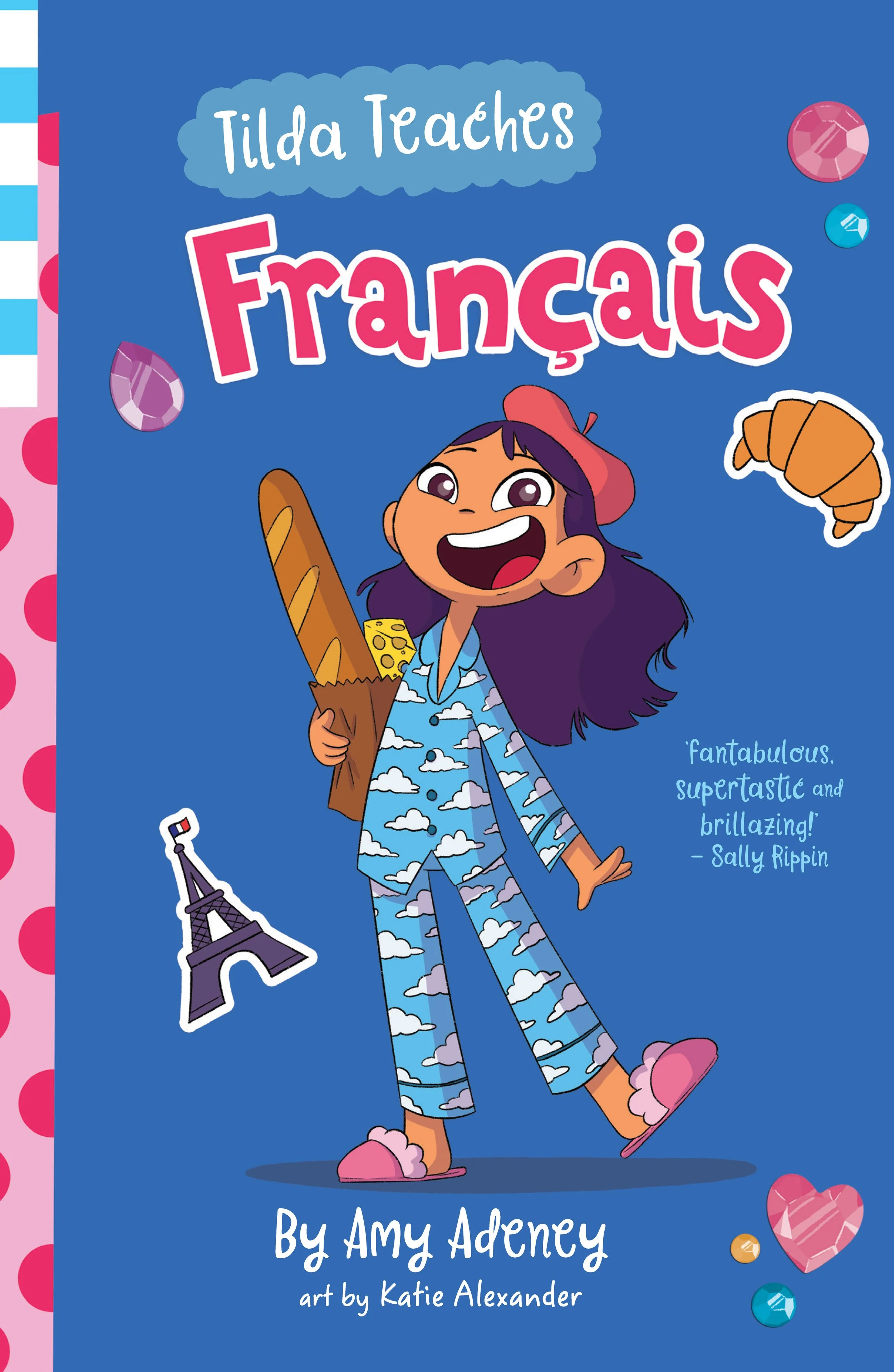Tilda Teaches Français Teaching Notes
Learning outcomes
Students will:
Learn about Venn Diagrams as a tool for categorising collections.
Write stories about characters experiencing FOMO.
Make posters explaining different strategies for staying calm.
Learn about French culture, food and language.
Synopsis
Tilda has had her tonsils out, and is very miserable to be stuck at home recovering while her friends Binky and Harry are at school celebrating French Week. She decides to run her own French school at home, and teach her favourite babysitter Lilly everything she knows about French. She makes a lesson plan, and teaches Lilly all about introducing herself, counting, and saying her colours in French. They even eat a delicious French picnic lunch and learn to sing a French song. Unfortunately, throughout the week, Tilda is continually reminded of what she’s missing out on at school, bringing up her feelings of anger about the unfairness of her situation. But Tilda learns that strategies such as deep breathing, colouring in, singing, dancing, and talking to Lilly all help her calm down. She is finally able to focus on all the fun she’s having at home, rather than on what she’s missing out on.
Themes
Fear of missing out
Anger
Sickness
Friendship
Before you read the story
Read the blurb:
Tilda has no tonsils. Last week she had her tonsils out, so this week Tilda is stuck at home recovering. Luckily, she has her babysitter Lilly to keep her company. But unluckily, it is French Week at school, and Tilda is missing out. This makes Tilda feel mangry. That’s right, mad and angry. She decides to have her own French Week and teach Lilly all the French words she knows. But will French Week at home really measure up?
What do you know about French? Do you know any words? Do you know what countries people speak French in?
Discussion Questions
Chapter 1
Have you ever had an operation? How did it make you feel?
Why is Tilda jealous of Baby Joe?
What are some of the reasons that Tilda loves her babysitter Lilly?
Chapter 2
Why is Tilda’s heart pounding and her hand shaking?
How does Tilda feel when she sees Binky and Harry walking past?
What do you like to do to distract yourself when you’re not feeling well?
Chapter 3
What are some of the French things that Tilda is going to teach Lilly? Do you agree that they’re the most important things for Lilly to learn?
Do you like doing tests? Can you think of any other kinds of assessment that you do at school?
What kinds of foods make you feel better when you’re feeling sick?
Chapter 4
Do you agree with Tilda that crumpets are the best breakfast ever? What’s your favourite breakfast?
Have a go at introducing yourself in French to the person next to you. Was it difficult?
Why does Lilly tell Tilda to take deep breaths?
Chapter 5
Have a go at reading the French numbers in Tilda’s teaching notebook. Do you find it tricky?
Have you ever made a Venn Diagram before? What can they be used for?
Why do Tilda’s hands roll into mangry fists?
Chapter 6
Have a go at saying some of the French colours that Tilda teaches Lilly. Can you find something in your classroom for each colour?
Do you enjoy colouring in? What else do you do that makes you feel sloaty?
Why does seeing her friends make Tilda feel like crying?
Chapter 7
Why is Tilda upset that Baby Joe is home from daycare today?
Do you know the song Frère Jacques? Can anyone in your class sing it? If not, check out this version.
What makes Tilda feel better about missing French Friday?
Chapter 8
In her Weekly Report, Tilda gives herself an A for teaching, because she asked an expert for help. Why is it important to sometimes ask an expert? What kinds of experts might teachers ask for help?
What are some of the ways Tilda learned to calm down? What are some things that help you calm down when you’re angry?
Tilda talks about FOMO in her Weekly Report, or Fear Of Missing Out. Have you ever felt that way? What were you scared of missing out on?
Activities
French Friday!
Organise your own French Friday party! Learn about French culture, try some French food, learn a song, and try some of the activities that Tilda does with Lilly. Maybe you could even dress up!
Draw a Venn Diagram!
Venn Diagrams are a useful tool to explore the relationship between a set of different things. Here’s a useful article on Twinkl to help you understand what Venn Diagrams are and how they can be used. Now it’s time to have a go! Start as a whole class, with two intersecting hoops positioned on the floor. Have everyone write their favourite animal on a sticky note. Choose two categories for the hoops, and then sort the animals accordingly. Category ideas might include:
Has feathers/fur/spots/stripes
Lives in the forest/jungle/desert/ocean/farm
Can be a pet
Is a herbivore/carnivore
Have a few different rounds, demonstrating that some of the animals belong in more than one category, and some belong outside the hoops if they don’t fit in either category. What other uses can you come up with for Venn Diagrams in the classroom?
Oh No, FOMO!
FOMO, or Fear of Missing Out, is something that most of us have experienced at some time. It might be missing out on a really fun concert or school excursion, or it might be feeling sad about not being available to go to a friend’s party. Write a story about someone who has FOMO. What are they missing out on? How do they feel? What do they do about it? Make it as imaginative as you can, and remember to make sure your story has a proper beginning, middle and end. How do they solve the problem?
Keep Calm!
Tilda learns some really great ways to calm down when she’s feeling angry – strategies that we could all use when we’re worked up, sad or cross. Make a ‘Keep Calm’ poster as a reminder of strategies that help you keep your cool. Maybe they’re the same as Tilda’s, or maybe you prefer other activities to help you chill, like listening to music or going for a walk. Choose some soothing colours to write or draw your ideas, and put your finished poster up somewhere useful (your bedroom wall? The fridge?) to look at next time you’re feeling mangry!



